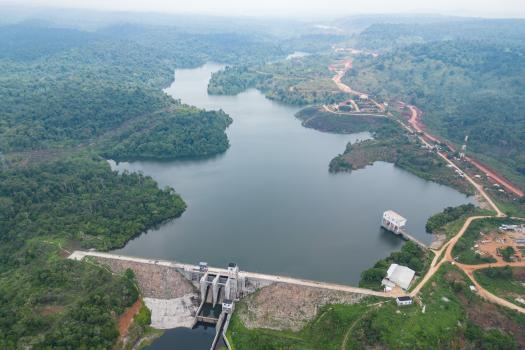CAMBODIA HYDRO-POWER ANALYSIS REPORT
1.0 Overview of Hydropower in Cambodia
The Mekong river which runs through Cambodia, is the major source of the country's hydropower. Hydropower accounts for about 40% of Cambodia’s total electricity generation. The development of these infrastructure has been continuously supported by the government, besides attracting significant amounts of Foreign Direct Investment (FDI). Illustrating this trend, the inaugurated Lower Sesan 2 hydropower dam, in Stung Treng province, is a USD 800 million Build Operate Transfer (BOT) partnership between Chinese, Vietnamese and Cambodian stakeholders.
Cambodia’s electrification rate is among the lowest in Southeast Asia and the country has the ambition of increasing the efficiency to 100%, but this project might cause the displacement of people from their homes for reasons such as needing large amounts of land for these projects and environmental changes. In 2017, Cambodian villagers had to leave their homes because of the flood caused by Lower Sesan II dam.
This report provides a summary of Cambodia’s hydropower sector, showcasing key details on existing and potential hydropower projects, such as their locations, statuses, capacities, and investors. It serves as a valuable resource for understanding the state of hydropower development across different regions in Cambodia and its role in the country’s renewable energy landscape.
2.0 Objectives of this analysis
The following objectives will guide our exploration of the Cambodian Hydropower Dataset:
- Explore the operational status of the dams
- Identify the provincial location of the dams
- Identify how many dams were built between the year 2012-2018
- Identify the average capacity of the dams
- What is the total capacity for large scale projects that are invested by Korea?
- What province will have the largest total capacity if all the projects are completed?
3.0 Data and Modeling Approach
The dataset used for this analysis was sourced from Kaggle and consists of 73 rows and 26 columns with each column containing key attributes such as geographic information, project details, and status indicators. The exploratory analysis was carried out using Power BI enabling an interactive examination of the data structure and trends. The data contains information about 73 dams but at the time of analysis, 74 dams are in existence.
3.1 Terms
Ogc_fid = Open Geospatial Consortium Feature ID
Eia_status = Environmental Impact Assessment Status
BTW = Between
3.2 Exploratory Data Analysis
3.2.1 Data Cleaning
The data was cleaned by removing 9 columns out of the 26 columns (irrelevant to this analysis). The deleted columns were altitude, geometry, detail_status, purpose, eia_date, reference, additional_references, last_update and language.
Also, the missing data on the energy column were replaced by the average energy. This is done by changing missing (NaN) values to 0. Then, the energy column was converted from the text data type to the whole number data type. The average was calculated and used to replace values that were set to 0.
3.2.2. Data Exploration
From our data, Cambodia has a total of 73 hydropower dams currently installed. The average capacity of the dams is estimated at 109 Megawatts (MW), which generates approximately 180 gigawatt-hours of electricity.
From figure 1 below, the potential sites can be grouped into two clusters and they are more than the operational and under study sites. It can also be seen that most of the operational dams are located in the South-Western part of Cambodia with only 2 being in the North-Eastern part of the country. The main reason for this is that the North-Eastern region of Cambodia has the Mekong River Basin where damming can cause major problems to fishing communities, biodiversity and local communities.
Fig.1: Map of Cambodia, highlighting the locations of the dams by status
So, it was deemed wiser to set up dams in the South-Western region where there are fewer critical fishing routes and a less dense population. Urban centers, e.g the capital city, Phnom Penh, are closer to the South-West region making transmission of power more effective. And lastly, there are mountain ranges in this part of Cambodia such as the Dâmrei Mountains and the Krâvanh Mountains which are suitable for dam construction because such elevations allow for the needed water flow and pressure for dam efficiency.
Fig.2: Bar Chart showing Dams Built Between 2012 to 2018
From the bar chart, no dams were built in 2014 due to intensified regional tensions, environmental concerns and lack of plan enforcement. Although more dams were built in 2017 and 2018 than the other years, they were not operational due to construction delays and project timelines.
Fig.3: Number of dams in each province
Koh kong has the highest number of dams. Three out of 11 of these dams are operational with two being large scale and one medium scale . If all the dams are operational, that is all potential and understudy dams are certified operational, Kratie will have the highest sum of 2,667 Megawatts in capacity.
Fig.4: Size scale of project and sum of capacity by province
Most of the hydropower dams are on a smaller scale but it can be seen that despite the small ratio of large scale projects they have the bulk of the total capacity.
4.0 Insights
By examining the operational status, provincial distribution, and construction timeline of the dams, we gain insight into both the current infrastructure and growth trends in hydropower. These insights include:
- The major percentage of the total capacity comes from the dams under study.
- The potential sites are more than both the operational and under study sites.
- In the year 2013 and 2018 only large scale projects (dams) were built.
- In 2016 two out of the twenty one large scale dam project were under study and they had the sum of 64 (MW) capacity from korea large scale investors
5.0 Recommendation
Implementing the list of recommendations below will improve the chance of Cambodia reaching her goal of achieving a high efficiency rate in their hydropower sector.
- We recommended that the dam building be sub-leased to private sectors who are expert dam-project managers so as to avoid what happened in 2014
- Cambodia should focus on more large-scaled dam-projects. Room should be made for more potential investors to come in as this will increase capacity and energy generation.
- Some measures should be implemented to protect the local ecosystems and biodiversities, such as reforestation, creating wildlife corridors and water quality standards.
- It can be seen that hydropower is the most consumed form of electricity in Cambodia.In this case, there should be more operational dam sites to help increase the production of hydropower energy.
6.0 Conclusion
In conclusion, Cambodia's hydropower investment is an important step in the country's journey to achieving a reliable energy source and economic expansion. Although hydropower projects have the potential to produce sustainable and renewable energy, they also present a number of social and environmental risks that could have consequences if not managed properly. Implementing laws that place a high priority on environmental protection and sufficient compensation for impacted communities is crucial to ensuring that hydropower benefits all Cambodians.
7.0 References
https://news.mongabay.com/2024/06/hydropower-dams-further-undermine-redd-efforts-in-cambodia/
https://opendevelopmentcambodia.net/topics/hydropower-dams
https://ourworld.unu.edu/en/real-costs-of-hydropower-in-cambodia
https://theaseanpost.com/article/cambodia-looks-hydropower
https://en.wikipedia.org/wiki/Energy_in_Cambodia
Appendices
Appendix 1: Table view
Appendix 2: Dashboard




